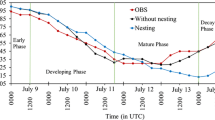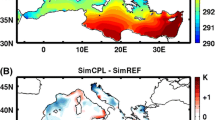Abstract
It is well recognized that sea surface temperature (SST) plays a dominant role in the formation and intensification of tropical cyclones. A number of observational/empirical studies were conducted at different basins to investigate the influence of SST on the intensification of tropical cyclones and in turn, modification in SST by the cyclone itself. Although a few modeling studies confirmed the sensitivity of model simulation/forecast to SST, it is not well quantified, particularly for Bay of Bengal cyclones. The present study is designed to quantify the sensitivity of SST on mesoscale simulation of an explosively deepening storm over the Bay of Bengal, i.e., Orissa super cyclone (1999). Three numerical experiments are conducted with climatological SST, NCEP (National Center for Environmental Prediction) skin temperature as SST, and observed SST (satellite derived) toward 5-day simulation of the storm using mesoscale model MM5. At model initial state, NCEP skin temperature and observed SST over the Bay of Bengal are 1–2°C warmer than climatological SST, but cooler by nearly 1°C along the coastline. Observed SST shows a number of warm patches in the Bay of Bengal compared with NCEP skin temperature. The simulation results indicate that the sea surface temperature has a significant impact on model-simulated track and intensity of the cyclonic storm. The track and intensity of the storm is better simulated with the use of satellite-observed SST.









Similar content being viewed by others
References
Bosart LF, Bracken WE, Molinary J, Velden CS, Black PG (2000) Environmental influences on the rapid intensification of hurricane Opal (1995) over the Gulf of Mexico. Mon Wea Rev 128:322–352
Brand S (1971) The effects on tropical cyclone of cooler surface waters due to upwelling and mixing produced by a prior tropical cyclone. J Appl Meteor 15:909–919
Braun SA, Tao W-K (2000) Sensitivity of high-resolution simulations of hurricane Bob (1991) to planetary boundary layer parameterizations. Mon Wea Rev 128:3941–3961
Cione JJ, Uhlhorn EW (2003) Sea surface variability in hurricanes: implications with respect to intensity change. Mon Wea Rev 131:1783–1796
De Angelis D (1976) World of tropical cyclones—North Indian Ocean. Mar Weather Log 20:191–194
DeMaria M, Kaplan J (1994) Sea surface temperature and the maximum intensity of Atlantic Tropical cyclones. J Climate 7:1324–1334
Dudhia J (1993) A non-hydrostatic version of Penn State–NCAR mesoscale model validation tests and simulation of an Atlantic cyclone and cold front. Mon Wea Rev 121:1493–1513
Evans JL (1991) Tropical cyclone sensitivity to sea surface temperatures. In: Preprints 19th Conference on Hurricanes and Tropical Meteorology. American Meteorological Society, Miami, pp 471–474
Fisher EL (1958) Hurricane and the sea surface temperature field. J Meteor 15:328–333
Gray WM (1968) Global view of the origin of tropical disturbances and storms. Mon Wea Rev 96:669–700
Gray WM (1975) Tropical cyclone genesis. Atmospheric Sciences, Paper No. 234. Colorado State University, Fort Collins, p 119
Grell G, Dudhia J, Stauffer DR (1995) A description of the fifth generation Penn State/NCAR Mesoscale Model (MM5). NCAR Technical Note NCAR/TN-398 + STR, p 122
Joly A, Browning KA, Bessemoulin P, Cammas J-P, Caniaux G et al (1999) Overview of the field phase of the Front and Atlantic Storm-Track Experiment (FASTEX) project. Quart J Roy Meteor Soc 125:3131–3163
Karyampudi VM, Lai GS, Manobianco J (1998) Impact of initial condition, rainfall assimilation and cumulus parameterization on simulation of Hurricane Florance (1988). Mon Wea Rev 126:3077–3101
Liu Y, Zhang D-L, Yau MK (1997) A multi-scale numerical simulation of hurricane Andrew (1992). Part-I: Explicit simulation and verification. Mon Wea Rev 125:3073–3093
Liu Y, Zhang D-L, Yau MK (1999) A multi-scale numerical simulation of hurricane Andrew (1992). Part-II: Kinematics and inner core structure. Mon Wea Rev 127:2597–2616
Malkus JS, Riehl H (1960) On the dynamics and energy transformation in steady-state hurricanes. Tellus 12:1–20
Mandal M, Mohanty UC, Raman S (2004) A study on the impact of parameterization of physical processes on prediction of tropical cyclones over the Bay of Bengal with NCAR/PSU mesoscale model. Nat Hazards 31(2):391–414
Merrill RT (1987) An experiment in statistical prediction of tropical cyclone intensity change. NOAA Tech Memorandum NWS NHC-34, Washington DC, USA, p 34
Miller BI (1958) On the maximum intensity of hurricanes. J Meteor 15:184–195
Mohanty UC, Mandal M, Raman S (2004) Simulation of Orissa super cyclone (1999) using PSU/NCAR mesoscale model. Nat Hazards 31(2):373–390
Namias J (1973) Birth of hurricane Anges—triggered by the trans-equatorial movement of a mesoscale system into a favourable large-scale environment. Mon Wea Rev 101:177–179
Ooyama K (1969) Numerical simulation of the life cycle of tropical cyclones. J Atmos Sci 26:3–40
Orlanski I (1998) Poleward deflection of storm tracks. J Atmos Sci 55:2577–2602
Palmen E (1948) On the formation and structure of tropical hurricanes. Geophysica 3:26–38
Reynolds RW, Smith TM (1994) Improved global sea surface temperature analyses. J Climate 7:929–948
Reynolds RW, Smith TM (1995) A high-resolution global sea surface temperature climatology. J Climate 8:1571–1583
Riehl H (1979) Climate and weather in the tropics. Academic Press, New York, p 394
Rosenthal SL (1971) The response of a tropical cyclone model to variations in boundary layer parameters, initial conditions, lateral boundary conditions, and domain size. Mon Wea Rev 99:767–777
Shay LK, Goni GJ, Black PJ (2000) Role of warm ocean feature on hurricane opal. Mon Wea Rev 128:1366–1383
Acknowledgements
The authors gratefully acknowledge the NCEP and NCAR for providing their reanalysis datasets and the model used in the present study. The NCEP, USA is also thankfully acknowledged for providing the climatological SST data used in the study. The National Remote Sensing Agency (NRSA) is acknowledged for providing the satellite-observed SST data. The authors also owe thanks to the India Meteorological Department for providing precipitation data and the observed track of the storm. The Department of Ocean Development, Government of India is gratefully acknowledged for providing financial support to carry out the work.
Author information
Authors and Affiliations
Corresponding author
Rights and permissions
About this article
Cite this article
Mandal, M., Mohanty, U.C., Sinha, P. et al. Impact of sea surface temperature in modulating movement and intensity of tropical cyclones. Nat Hazards 41, 413–427 (2007). https://doi.org/10.1007/s11069-006-9051-8
Received:
Accepted:
Published:
Issue Date:
DOI: https://doi.org/10.1007/s11069-006-9051-8




